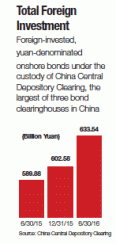To view a PDF of the report, click here.
By Eric Johnson
China’s transition to a market-based, globally integrated economy has spanned nearly four decades, marching progressively forward but at a tortoise-like pace that even Beijing policymakers readily admit has been slow.
“China has gone through a long period of transition,” the nation’s central bank chief, Zhou Xiaochuan, acknowledged in June at an International Monetary Fund event in Washington.
Yet China’s lumbering tortoise also has a reputation for breaking into sprints whenever prodded by market-jolting reforms. One such jolt came last February, when Zhou’s People’s Bank of China (PBOC) lifted all restrictions on foreign institutional investor participation in what’s now a US$ 9 trillion bond market – the world’s third-largest debt securities deck, behind only the United States and Japan.
Global investors immediately took note. Analysts hammered out reports. Asset managers rethought China portfolios. And potential bond issuers from state-owned enterprises (SOEs) to local governments in China’s fast-growing cities saw in the PBOC decision fresh incentive to streamline debt management.
Weighing in with a China bond market endorsement was the World Bank, which August 12 said PBOC had approved its request to issue about US$ 2.8 billion worth of bonds denominated in its Special Drawing Rights “currency” and payable in yuan.
Meanwhile, among institutional investors familiar with the China playing field and its lengthy transition, the usual questions resurfaced. They asked: What’s the risk? Has China SOE corporate governance improved enough that fixed-income investors can safely supplement credit extended by government-owned banks? Are indebted city governments shifting to more transparent budgeting practices to accommodate conservative bond holders? How might opening the debt securities market affect China’s capital movement and currency exchange controls? And what about China’s domestic bond ratings system... is it really reliable?
Straightforward answers seldom come easily in China. The market transition has never been formulaic. And the regulator rulebook is dynamic, subject to rapid adjustments and regional variations.
That authorities are now keen on attracting foreign investors into bonds reflects a deep interest in letting market forces decide the fate of indebted companies and state-owned enterprises in the context of the nation’s ongoing economic slowdown. Bank non-performing loan ratios early in the second half 2016 were creeping toward 2 percent.
Beijing also sees a foreigner-friendly bond market as a preferred alternative to the so-called “local government financing vehicles,” shadow banking and credit schemes that governments and many companies traditionally have relied upon whenever state banks, often under government orders, tighten lending.
Moreover, the bond market has matured to the point where authorities obviously feel comfortable about inviting overseas institutional investors.
Directing traffic are China Central Depository Clearing (CCDC), Shanghai Clearing House (SCH), and China Securities Depository and Clearing (CSDC). The first two clearinghouses handle interbank bond trades, while the third concentrates on bonds traded on China’s stock exchanges.

These figures are so big that hard-to-answer questions obviously won’t stop global investors from knocking on China’s door.
“Foreign investors can’t afford not to have a stake in what may eventually be the biggest bond market in the world,” explained Edmund Goh, the Asia fixed-income team investment manager at Aberdeen Asset Management, which has US$ 96 billion in fixed-income assets under management.
It’s also been argued that the latest bond reform should be viewed as part of a financial infrastructure-building process that deserves both trust and institutional investor support.
“China’s bond market on the whole offers opportunities that more than offset the risks,” said Jacqueline Zhang, assistant general manager of Ping An Asset Management, which as of December 2015 reported 1.6 trillion yuan worth of fixed-income assets under management. “It remains a blue ocean worthy of offshore investor interest.”
After noting that corporate bond defaults had jumped in the first half of 2016, a recent Bank of China analysis frankly predicted a further increase defaults in the second half. But rather than fueling fear, the report said, these defaults prove the market transition is having a desired impact.

| 
|
| Jacqueline Zhang Ping An Asset Management | Edmund Goh Aberdeen Asset Management |
| “China’s bond market on the whole offers opportunities that more than offset the risks. It remains a blue ocean worthy of offshore investor interest.” | “Foreign investors can’t afford not to have a stake in what may eventually be the biggest bond market in the world.” |
Indeed, at earlier stages of the transition, defaults were often prevented by governments keen to bail out taxpaying SOEs with big payrolls and official influence. Implicit bailout guarantees emboldened SOEs to build beyond customer demand, distorted retail investing and saddled banks with bad debt.
Efforts to end bailout guarantees, consolidate SOE operations and rein in shadow banking through stricter regulations were reform steps built into the market transition process in recent years. Now, bond defaults are being allowed.
The bond market now open to foreign investors is “equipped to manage and absorb default risk” through “risk control within the scope of what the market can bear,” the report said.
Sharing that assessment is Liu Qingchuan, a managing director and IB bond section chief at China International Capital Corp. Ltd. (CICC), one of China’s leading investment banks.
“If no one defaults, then all credit risk is equal... and there’s no risk premium. Everyone looks the same,” said Liu. “It’s healthy for the bond market to see some defaults.”
And Ping An’s Zhang isn’t worried. She said the current hazard level associated with the nation’s economic slowdown is “not severe enough to result in large-scale defaults or systemic risk.”
Holding Back
Before the February reform, a limited number of yuan-denominated bonds issued by China’s central and local governments, SOEs and other entities were available to foreign firms and sovereign wealth funds, mainly through the nation’s quota-based Qualified Foreign Institutional Investor (QFII) and Renminbi Qualified Institutional Investor (RQFII) schemes. The number of overseas participants had gradually increased after a small batch of foreigners became the first invited to buy bonds in 2010, reaching 328 institutional investors on June 30, according to CCDC.
QFII-RQFII players were on board in 2014 when Beijing introduced a reform program that, in a key market jolt, for the first time gave local governments permission to issue municipal bonds. Previously, only the central government’s Ministry of Finance and financing vehicles could issue bonds on behalf of local governments to raise money for public works and other civic projects.
The muni market move gave local governments a green light to convert their financing vehicle debt, considered dangerously opaque, into bonds.
Nevertheless, neither the 2014 decision nor any subsequent reform measure apparently went far enough to attract more than a smattering of overseas investment. According to the State Administration of Foreign Exchange, foreign investors held less than 2 percent of all outstanding bonds by value last January.
The foreign share of the market climbed modestly after the bond reform announcement in February. As of June, some 2.6 percent of the interbank market’s investors were foreign, while offshore institutions held 1.3 percent of the total available through in China’s bond market.
The reform has added to the foreign inflows that had been steadily rising in recent years through QFII and other schemes. Between 2013 and June, Zhang said, offshore institution bond holdings doubled to US$ 105 billion. CCDC said 48 percent of that amount was in government bonds, 43 percent in paper for banks and other financial institutions, and the rest in corporate bonds.
So far, foreign investors have been playing it safe. Most of Aberdeen’s holdings, for example, are in China’s central government bonds “since they are the most liquid,” Goh said.
What’s holding back foreign players? It’s not a lack of opportunity, as underscored by a bond demand boom in the first half of this year that CICC analysts said would likely continue in the second half. A CICC report said “ample liquidity and a scarcity of quality bonds” offer “the strongest logic” for the boom, which has been led by domestic investors.
Still, the negatives are nagging for many foreign investors.
One factor to consider is China’s unique, foreign currency exchange system. A sharp devaluation of the yuan in August 2015 caught investors by surprise. Goh expressed a common opinion: “Most (foreign) investors will carefully consider the currency risk before committing” to China bonds, he said.
And the credit rating system, which is run by Chinese firms such as Dagong Global Credit Rating, has been shadowed by doubts. Goh called ratings in China “unreliable” and one of the “big impediments to foreign investors pouring money into the China bond market.”
A recent Credit Suisse report by Hong Kong analysts Vincent Chan and Shen Hu called credit ratings “the Achilles heel” of the China corporate bond market and argued implicit government support for SOEs has yet to be resolved.
“China’s corporate bond rating seems to not only reflect the financial position of the company but assumes that it will be somehow bailed out in case of any repayment problems,” the report said.
Liu, however, sees the ratings environment in a different light. Only domestic agencies have what it takes to examine bonds in the China context, he said, particularly the hard-to-recognize relationships between bond issuer and one or more government entities.
“Rating is an art, not a science,” Liu said. “Ratings agencies don’t predict the chance of a default. It’s all about opinions, perspectives. Dagong has its China-based perspective.”
So how an international investor responds to China’s latest invitation to buy bonds may ultimately reflect trust in the government’s ability to deliver growth and steer the economy forward, even if that means moving as slowly as a tortoise.
Goh explained that Aberdeen’s allocation to China onshore debt had been “pretty stable over the past few years” before the bond reform took effect because QFII quota restrictions “made it difficult for us to move capital in and out of the country.” And the yuan “is still a currency that operates under many restrictions.”
The environment since the reform was introduced in February has not changed significantly, Goh said.
“However, with the opening up of the China interbank bond market to foreigners, giving us greater access without having to rely on the QFII and Renminbi Qualified Foreign Institutional Investor schemes, we would consider increasing our exposure,” Goh said.
Indeed, among institutional investors it’s now clear this tortoise can really sprint.
Addressing the IMF, the PBOC’s Zhou said the regulatory structure for overseeing China’s financial markets – including the bond market – has been designed for a long-haul transition to a market economy. There are no shortcuts.
“China has gone through a long period of transition which has been reflected in the PBOC’s institutional arrangement,” Zhou said. “Ultimately, the transition to a market economy will, by and large, be completed.”





